Hayetchaieb
Hayet Chaieb
Resources for educators of kids in grades 4-12. BA - Balanced Assessment in Mathematics. Internet4Classrooms - Helping Students, Teachers and Parents Use the Internet Effectively. PE Central - Lesson Plans. Understanding Inquiry in Health and Physical Education. What is Inquiry-Based Learning “Inquiry-based learning is a process where students are involved in their learning, formulating questions, investigate widely and then build new understandings, meanings and knowledge.
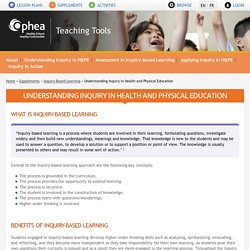
That knowledge is new to the students and may be used to answer a question, to develop a solution or to support a position or point of view. The knowledge is usually presented to others and may result in some sort of action.
" 1 Central to the Inquiry-based learning approach are the following key concepts: The process is grounded in the curriculum.The process provides the opportunity to extend learning.The process is recursive.The student is involved in the construction of knowledge.The process starts with questions/wonderings.Higher-order thinking is involved.
The Health and Physical Education Web site for Teachers/PE Central. Teacher Resources. Health Education. HEALTH LESSON PLANS - Health lesson plans for elementary teachers. Free printables and classroom reproducibles.
Exercise: An Antidote for Behavioral Issues in Students?
MONDAY, Jan. 9, 2017 (HealthDay News) -- Children with serious behavioral disorders might fare better at school if they get some exercise during the day, a new study suggests.

The researchers focused on children and teenagers with conditions that included autism spectrum disorders, attention deficit hyperactivity disorder (ADHD), anxiety and depression. They looked at whether structured exercise during the school day -- in the form of stationary "cybercycles" -- could help ease students' behavioral issues in the classroom. Over a period of seven weeks, the study found it did. Kids were about one-third to 50 percent less likely to act out in class, compared to a seven-week period when they took standard gym classes. Those effects are meaningful, according to lead researcher April Bowling, who was a doctoral student at Harvard University at the time of the study.
"That's important for their learning, and for their relationships with their teachers and other kids in class," she said. The U.S.
Class Charts - seating plans and behavior management software. Class Charts - seating plans and behavior management software. Better Classes Improve Behavior of Special Needs Kids. Updated January 14, 2016.
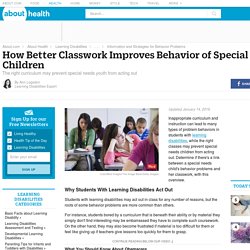
Inappropriate curriculum and instruction can lead to many types of problem behaviors in students with learning disabilities, while the right classes may prevent special needs children from acting out. Determine if there's a link between a special needs child's behavior problems and her classwork, with this overview. Why Students With Learning Disabilities Act Out Students with learning disabilities may act out in class for any number of reasons, but the roots of some behavior problems are more common than others. For instance, students bored by a curriculum that is beneath their ability or by material they simply don't find interesting may be embarrassed they have to complete such coursework.
Continue reading below our video Loaded: 0% Progress: 0% As a result, they may feel defensive and disrupt the classroom to protect their egos or attempt to restore their "image" before classmates.
Education Support Partnership – supporting you to feel your best. Disruptive pupil behaviour is a frustration for many teachers.

In fact, 70% of teachers told us they had considered quitting the profession over poor behaviour. (Teacher Support Network and Family Lives Behaviour survey 2010) Poor behaviour is a barrier to learning and can easily threaten the health and wellbeing of teachers. On top of other pressures that can occur, the result is lost teaching days, unhappy teachers and failing students.
IRIS Resource Locator. Center on Enhancing Early Learning Outcomes (CEELO) The Center on Enhancing Early Learning Outcomes (CEELO) works to strengthen the capacity of state education agencies (SEAs) to lead sustained improvements in early learning opportunities and outcomes.
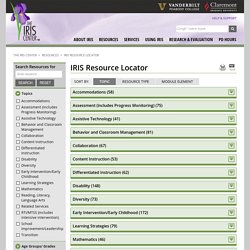
Resources on this site include publications, webinars, and presentations about EI/ECE assessment, as well as links to other centers. The CEELO Annotated Bibliography on Early Childhood Assessment highlights resources found on the Website. This center works in partnership with SEAs, state and local early childhood leaders, and other federal and national technical assistance providers to promote innovation and accountability. To help SEAs improve services for infants, toddlers, and young children, resources on this site include publications, webinars, presentations, and links to other Websites for various topics: assessment, data, practices for children from birth through third grade, workforce, systems, and child outcomes.
College Quarterly - Articles - Managing Disruptive Behaviour in the Classroom.
College Quarterly Summer 2011 - Volume 14 Number 3 Managing Disruptive Behaviour in the Classroom By Catherine Deering, Ph.D.

Abstract Both faculty and students at many colleges and universities report numerous incidents of disruptive and uncivil behaviour. Both faculty and students at many colleges and universities report numerous incidents of disruptive and uncivil behaviour(Bjorkland & Rehling, 2010; Seeman, 2010; Clark & Springer, 2007).
Pluriel 50 fiches. Mini-leçons_écriture_P1.pdf. Suivi_de_l'écriture_fiche_eleve.pdf. Suivi_de_l'écriture_affichage.pdf. Suivi_de_l'écriture_crayons_individuels.pdf. Redaction code auto correction.pdf. Outils pour le maitre. Expression écrite CE1. (illustration couverture: Mysticlolly) édition du 08/07/2016 : ajout des couvertures CE2 et CE1-CE2 édition du 24/07/2016 : ajout des progressions CE2 et CE1-CE2. Production écrite en CM2, dur-dur. Moi je commence par leur faire trouver les critères de réussite.
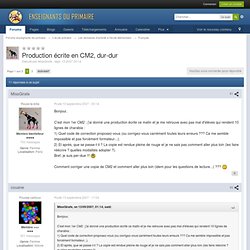
Par exemple, en ce moment je travaille sur Joker de Morgenstern et je vais leur demandais d'inventer un texte où un des élèves de la classe aura utilisé un joker. Les critères de réussite seront donc : "Mon héros est un personnage du roman " "Le joker utilisé appartient à ceux décrits dans le livre"etc...En général, je ne mets pas plus de 5 critères. Je les laisse écrire leur premier jet et je corrige uniquement les critères, c'est-à-dire que j'indique à côté de chaque critère si c'est acquis, en cours ou non acquis. Je leur rend leur 1er jet ainsi commenté et je les laisse améliorer leur texte. Je corrige ensuite l'ORL grâce à un code de correction (O=orthographe, A=accent, C=conjugaison...).Ils corrigent leurs erreurs avec les dictionnaires et le Bescherelle et ils me rendent leur dernier jet, écrit au propre. ).
3-mots-1-histoire-LB-.pdf. Fiches memo redac -lb-.pdf. Laclassebleue TV. Laclassebleue TV. Le-guide-du-ptit-écrivain.pdf. Banque d'activités pédagogiques. Activité visant à faire découvrir aux élèves des informations intéressantes sur des patronymes communs dans la communauté ou dans la région par l'examen des préfixes et des suffixes.

À partir du bottin téléphonique, ils les répertorieront et les classeront tout en discutant des liens d'autres cultures avec la francophonie du milieu.
Petite section - Programme de Maternelle - Fiches pédagogiques pour enseignants et professeurs des écoles - FichesPédagogiques.com. Interdisciplinaire. - Fiches pédagogiques pour enseignants et professeurs des écoles - FichesPédagogiques.com. Bricolages de Noël pour l'école on Pinterest. Authentification - Sos-Devoirs.
Moteur de recherche. A. Expression.pdf. Affiches pour la classe. L'an dernier, pour mes CP, j'avais fait une petite frise des nombres de 1 à 10 en format horizontal à scotcher sur leur pupitre (ici).
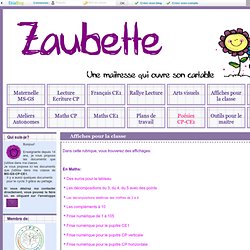
A l'usage, je me suis aperçue que bien souvent, ils posaient leur trousse dessus et que ma frise n'avait pas grand intérêt, cachée de la sorte...
Tableaux d'encodage CP. Découverts chez lamaitresseaime, je me suis mise aux tableaux d'encodage!
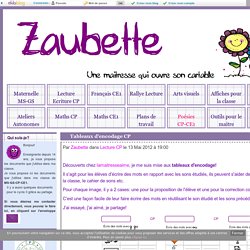
Il s'agit pour les élèves d'écrire des mots en rapport avec les sons étudiés, ils peuvent s'aider de référents comme les affichages de la classe, le cahier de sons etc. Pour chaque image, il y a 2 cases: une pour la proposition de l'élève et une pour la correction collective. C'est une façon facile de leur faire écrire des mots en réutilisant le son étudié et les sons précédents. J'ai essayé, j'ai aimé, je partage!
Évaluations CE1.










